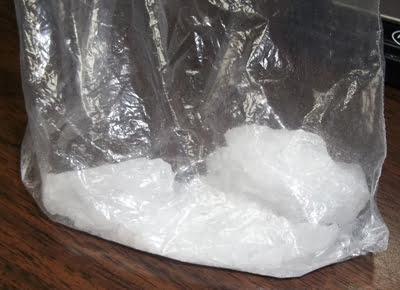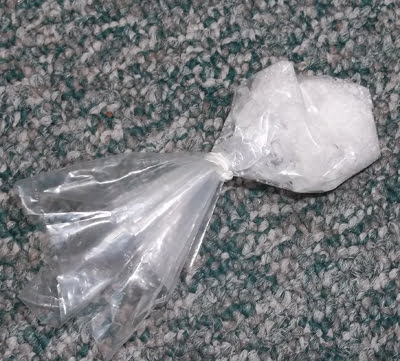

Jaynell Graham
Editor
Troopers from the West Virginia State Police – Marlinton Detachment found a large “rock” of meth this past summer during a search of a home in the southern part of the county.
Most people are not familiar with methamphetamine, and that is a good thing – in most cases.
But if you suspect someone in your household is using it, you need to educate yourself on the effects and dangers of the debilitating concoction for users– as well as the emotional and financial damage it can do to family and friends.
Sgt. Guy Deweese, Commander of the Marlinton Detachment, said meth is used in many ways – smoked, melted in water or alcohol and injected, snorted and the latest craze “hot railing.”
“Everything in meth is poisonous,” Deweese said, “other than the pseudoephedrine.”
According to the National Institute of Drug Abuse, methamphetamine, commonly referred to as meth, is a stimulant drug usually used as a white, bitter-tasting powder or a pill. Crystal meth is a form of the drug that looks like glass fragments or shiny, bluish-white rocks. Other common names for methamphetamine include chalk, crank, crystal, ice and speed.
What ingredients go into making meth?
Well, there is acetone, which is found in nail polish remover and paint thinner.
Anhydrous ammonia which is found in some cleaners and fertilizer.
The pseudoephedrine, found in some cold medicines and diet pills, sounds safe enough, but in large quantities it damages the respiratory system, nervous system and the heart.
Hydrochloric acid is thrown into the mix. It’s normally used in making plastic, and is so corrosive that it can eat away a person’s flesh.
Lithium from batteries is also used in the process. Lithium burns the skin and is highly explosive. Everyone has read about explosions as a result of a meth lab going bad.
Sodium hydroxide or lye is also used, as well as sulfuric acid which is found in drain and toilet cleaners. Coleman fuel… and the list goes on.
The chemical mixture basically turns into a gas generator, and when the pseudoephedrine pills are added, it separates into crystals.
Deweese said law enforcement hasn’t encountered many meth labs recently, because crystal meth is coming into the county, and the implementation of NPLEx has made had an effect, as well.
NPLEx, the National Precursor Log Exchange, is a real-time electronic logging and compliance system that tracks sales of over-the-counter cold and allergy medications containing pseudoephedrine. This monitoring makes it difficult, if not nearly impossible, for an individual to purchase the number of pills needed to make a full “run” of meth.
Unfortunately, meth users found a way to make small doses in a process known as “shake and bake.”
While this particular drug is not as pure as crystal, the potential damage from the process needs to be noted.
Shake and bake meth is made in a plastic soda bottle, and once the user has what they want, they often pitch the bottle out along the highway. These bottles are considered hazardous material and could present a problem to well-meaning “Adopt a Highway” groups.
Let’s look at how meth affects the health of the individual addict.
Because the “high” from the drug both starts and fades quickly, users often take repeated doses in a “binge and crash” pattern.
“Meth is a stimulant,” Deweese said. “People who use it can go for days without sleeping.”
Users also suffer severe side effects, such as “meth mouth.”
That term is derived from this particular drug practice, where the fumes from smoking meth destroy the enamel on the teeth, causing them to quickly decay.
“Paranoia is another side effect,” Deweese said.
“Pick marks on the skin are associated with the paranoia. These picks are an external sign of use, and are caused by the user scratching themselves, because they think there are bugs in their skin.
“As the drug destroys the receptors in the brain, users often become obsessive compulsive, and will focus on one thing for days on end.”
Is there hope or help for people who have fallen into meth addiction?
“There is help available,” Deweese said, “but it comes down to the user being willing to quit.
“They need help, but you can’t just say ‘I’m going to quit.’
“Relapse remains high, but the addiction can be overcome with treatment.”
While much has been written and researched about drug addiction, it is unfortunate that many parents, family members and friends who suffer the highs and lows right along with the addict often get no help or support for several reasons.
The first is denial.
No one wants to believe that their child, wife, husband, grandchild – too often parent – has fallen into this abyss.
Excuses abound, and finances dwindle as one or more family members become enablers by refusing to call addiction what it is. Years go by. The addict falls further into the habit. The family falls further into debt and dysfunction.
The addict will “clean up” for a few days. There are sighs of relief all around, and hope springs eternal.
Unfortunately, the clean-up doesn’t last, and the addict dives in again, dragging his or her loved ones with them.
Most people think theirs is a unique situation, but by taking the step of joining a support group, most find that the situation is actually quite “textbook,” – everyone is fighting the same battles.
For anyone finding themselves on either side – addict or the one who loves an addict – I would recommend reading Beautiful Boy – A Father’s Journey Through His Son’s Addiction, by David Sheff.
Perhaps one of the most important messages from this true story is aimed at the ones who find themselves lying awake at night, worrying and feeling guilty.
Throughout the book Sheff finds himself feeling responsible for his son’s addiction. But he combats those thoughts by reminding himself of the “three Cs.”
“You didn’t Cause it. You can’t Control it. You can’t Cure it.”
Overview of A Beautiful Boy from amazon.com:
“What had happened to my beautiful boy? To our family? What did I do wrong? Those are the wrenching questions that haunted David Sheff’s journey through his son Nic’s addiction to drugs and tentative steps toward recovery.
Before Nic became addicted to crystal meth, he was a charming boy, joyous and funny, a varsity athlete and honor student adored by his two younger siblings.
After meth, he was a trembling wraith who lied, stole and lived on the streets. Sheff traces the first warning signs: the denial, the three a.m. phone calls – is it Nic? the police? the hospital? His preoccupation with Nic became an addiction in itself.
But as a journalist, he instinctively researched every treatment that might save his son.
And he refused to give up on Nic.”
Beautiful Boy is available from Amazon and most book sellers.
An audio version of the book is available at McClintic Library in Marlinton.
Print editions are available at McClintic, Linwood and Hillsboro Public libraries.
The movie Beautiful Boy was released in October by Amazon Studios.
Sheff is the author of several books. His ongoing research and reporting on the science of addiction earned him a place on Time magazine’s list of the World’s Most Influential People.
Visit David at DavidSheff.com and on Twitter @david_sheff.


